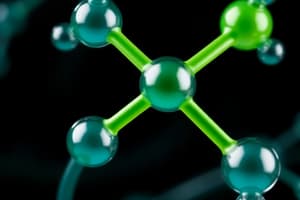Podcast
Questions and Answers
What type of bond involves the transfer of electrons between atoms?
What type of bond involves the transfer of electrons between atoms?
- Ionic Bonds (correct)
- Covalent Bonds
- Metallic Bonds
- Van der Waals Forces
Which state of matter is characterized by having a fixed shape and volume?
Which state of matter is characterized by having a fixed shape and volume?
- Gas
- Solid (correct)
- Plasma
- Liquid
What is the balanced chemical equation for a decomposition reaction?
What is the balanced chemical equation for a decomposition reaction?
- AB + CD → AD + CB
- A + B → AB
- A + BC → AC + B
- AB → A + B (correct)
Which of the following occurs in exothermic reactions?
Which of the following occurs in exothermic reactions?
On the pH scale, what is the range that indicates a substance is acidic?
On the pH scale, what is the range that indicates a substance is acidic?
Which of the following best describes metalloids?
Which of the following best describes metalloids?
According to the law of conservation of mass, what happens during a chemical reaction?
According to the law of conservation of mass, what happens during a chemical reaction?
Which equation correctly represents a synthesis reaction?
Which equation correctly represents a synthesis reaction?
What defines a base in terms of proton exchange?
What defines a base in terms of proton exchange?
What type of reaction involves a hydrocarbon and oxygen to produce carbon dioxide and water?
What type of reaction involves a hydrocarbon and oxygen to produce carbon dioxide and water?
Flashcards are hidden until you start studying
Study Notes
Basic Concepts in Chemistry
- Atoms: Fundamental units of matter, composed of protons, neutrons, and electrons.
- Molecules: Groups of atoms bonded together; can be elements (e.g., O₂) or compounds (e.g., H₂O).
- Chemical Bonds:
- Ionic Bonds: Formed through the transfer of electrons between atoms (e.g., NaCl).
- Covalent Bonds: Formed through the sharing of electrons (e.g., H₂).
- Metallic Bonds: Involves a sea of delocalized electrons around metal atoms.
States of Matter
- Solids: Fixed shape and volume; particles are closely packed and vibrate in place.
- Liquids: Fixed volume but no fixed shape; particles are close but can move past one another.
- Gases: No fixed shape or volume; particles are far apart and move freely.
Chemical Reactions
-
Types of Reactions:
- Synthesis: A + B → AB
- Decomposition: AB → A + B
- Single Replacement: A + BC → AC + B
- Double Replacement: AB + CD → AD + CB
- Combustion: Hydrocarbon + O₂ → CO₂ + H₂O
-
Law of Conservation of Mass: Mass is neither created nor destroyed in a chemical reaction.
The Periodic Table
- Elements: Organized by atomic number; groups/families share similar chemical properties.
- Metals: Typically shiny, good conductors, malleable, ductile.
- Nonmetals: Varied appearance; poor conductors, brittle in solid form.
- Metalloids: Exhibit properties of both metals and nonmetals.
Acids and Bases
- Acids: Substances that donate protons (H⁺); have a sour taste (e.g., HCl).
- Bases: Substances that accept protons; have a bitter taste and slippery feel (e.g., NaOH).
- pH Scale: Measures acidity (0-6) or basicity (8-14); 7 is neutral.
Stoichiometry
- Involves calculations based on balanced chemical equations to determine the amounts of reactants and products.
Thermodynamics
- Endothermic Reactions: Absorb heat; feel cold.
- Exothermic Reactions: Release heat; feel hot.
Chemical Kinetics
- Study of reaction rates and the factors affecting them (e.g., concentration, temperature, catalysts).
Chemical Equilibrium
- State in which the rate of the forward reaction equals the rate of the reverse reaction; can be shifted by changes in concentration, temperature, or pressure (Le Chatelier's principle).
Basic Concepts in Chemistry
- Atoms: The smallest unit of matter, made up of protons, neutrons, and electrons.
- Molecules: Composed of two or more atoms bonded together, can exist as elements (e.g., O₂) or compounds (e.g., H₂O).
- Chemical Bonds:
- Ionic Bonds: Formed when atoms transfer electrons, resulting in charged ions (e.g., sodium chloride, NaCl).
- Covalent Bonds: Occur when atoms share electrons (e.g., diatomic hydrogen, H₂).
- Metallic Bonds: Characterized by a 'sea' of delocalized electrons surrounding metal atoms, contributing to conductivity.
States of Matter
- Solids: Have a definite shape and volume; particles are tightly packed and primarily vibrate in position.
- Liquids: Maintain a fixed volume but adopt the shape of their container; particles are close yet mobile.
- Gases: Lack both fixed shape and volume; particles are widely spaced and move freely, filling their container.
Chemical Reactions
- Types of Reactions:
- Synthesis: Combination of reactants to form a single product (e.g., A + B → AB).
- Decomposition: Breakdown of a compound into simpler substances (e.g., AB → A + B).
- Single Replacement: An element replaces another in a compound (e.g., A + BC → AC + B).
- Double Replacement: Exchange of components between two compounds (e.g., AB + CD → AD + CB).
- Combustion: Reacts a hydrocarbon with oxygen to produce carbon dioxide and water (e.g., Hydrocarbon + O₂ → CO₂ + H₂O).
- Law of Conservation of Mass: States that mass remains constant; cannot be created or destroyed in chemical reactions.
The Periodic Table
- Elements Organization: Arranged by increasing atomic number; elements in the same group share similar properties.
- Metals: Characterized by luster, high conductivity, malleability, and ductility.
- Nonmetals: Exhibit a variety of appearances; typically poor conductors and brittle in solid form.
- Metalloids: Possess characteristics intermediate between metals and nonmetals.
Acids and Bases
- Acids: Substances that release protons (H⁺), often tasting sour (e.g., hydrochloric acid, HCl).
- Bases: Substances that accept protons, usually tasting bitter and feeling slippery (e.g., sodium hydroxide, NaOH).
- pH Scale: A measurement system for acidity and basicity; ranges from 0 (acidic) to 14 (basic), with 7 representing neutrality.
Stoichiometry
- Focuses on quantitative relationships in chemical reactions, utilizing balanced equations to calculate the amounts of reactants and products.
Thermodynamics
- Endothermic Reactions: Chemical processes that absorb heat from the surroundings, causing a cooling sensation.
- Exothermic Reactions: Chemical processes that release heat, often resulting in increased temperature.
Chemical Kinetics
- Investigates the rates of chemical reactions and the effects of variables such as concentration, temperature, and catalysts on these rates.
Chemical Equilibrium
- Achieved when the forward and reverse reactions occur at the same rate; influenced by changes in concentration, temperature, or pressure in accordance with Le Chatelier's principle.
Studying That Suits You
Use AI to generate personalized quizzes and flashcards to suit your learning preferences.





